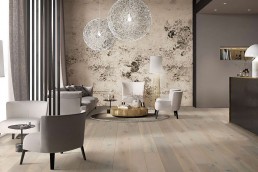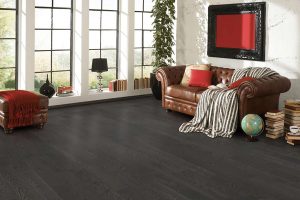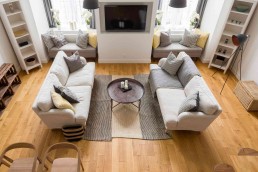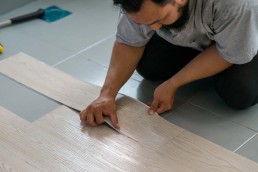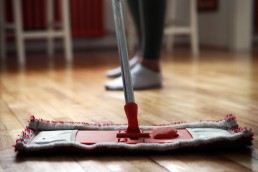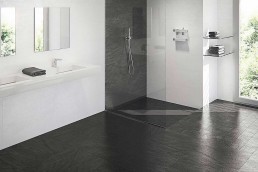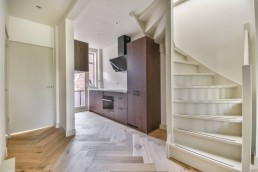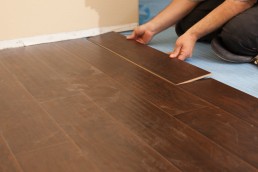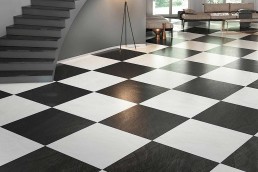The Guide to choosing Luxury Vinyl Flooring
Choosing any flooring for your home or office, its a big decision. You are making a significant financial decision, and its going to be there (hopefully) for 10-20 years. So making sure you do your own due diligence when picking flooring is very important. This blog is going to help walk you through the things you should consider when looking at Luxury Vinyl flooring for your next project.
What types of Luxury Vinyl are there?
When looking at Luxury Vinyl Flooring, there are two options: Luxury Vinyl Planks or Luxury Vinyl Tiles. Planks are shaped more like traditional hardwood floor planks, while the Tile pieces are squared like your typical tile flooring. The LVT floors can replicate natural materials such as marble, stone, or travertine. There are endless pattern combinations, giving you many different possibilities, helping you find exactly what you had envisioned.
LVP Flooring offers many different looks and patterns that are similar to hardwood flooring. Many people want hardwood flooring, but do not want the hassle of maintaining them, or having to pay extra for them.
Making the right selection with Luxury Vinyl
- Set a budget that works for you
- Making sure you set a budget that works for you is one of the most important steps of this process. You never want to spend more than you can afford on flooring, so coming into this process knowing your budget, will help you determine options that are feasible for your project.
- Consider whether you want LVP flooring or LVT flooring
- Take a look at both options. Take some samples home and see what you think looks best. Ultimately it comes down to your personal preference, so make sure its what you love!
- Choose a color that aligns with the design of your living space or business
- With LVT and LVP, there are endless designs and patterns to consider. Make sure you have a flooring expert walk you through all the potential possibilities so you know exactly what is our there.
- Assess the durability of the various options
- You never want to pick an item that wont last. Do your research into the Luxury Vinyl Flooring your considering, make sure it can meet the physical demands and wear and tear that they will go through on a day-to-day basis.
Next Steps
Following these initial steps is the first step. Talking with a team member and having them walk you through all the different options available and answer any questions or concerns you have is also very important. Contact one of our team members today to learn more about LVP. We would love to walk you through the journey of starting your next project.
When to use Luxury Vinyl, Tile, and Hardwood
Regarding flooring options for your home, three popular choices stand out for their durability, aesthetics, and versatility: luxury vinyl, hardwood, and tile. Each of these materials has unique advantages, making it essential to consider your lifestyle and design preferences when deciding which is right for your space.
Luxury Vinyl Flooring: Style Meets Practicality
Luxury vinyl flooring has gained quite a popularity in recent years due to its combination of style, affordability, and durability. It's an excellent choice for those who want the look of hardwood or tile without the associated costs and maintenance. Here are some key features of luxury vinyl:
- Aesthetic Versatility: Luxury vinyl comes in a wide range of colors, patterns, and textures, making it a versatile option for various design aesthetics.
- Durability: It's highly resistant to wear and tear, water, and scratches, making it ideal for high-traffic areas and homes with pets or children.
- Easy Maintenance: Luxury vinyl is a breeze to clean and maintain and can withstand spills and moisture.
- Affordability: It's often more budget-friendly than hardwood or tile, making it an attractive choice for cost-conscious homeowners.
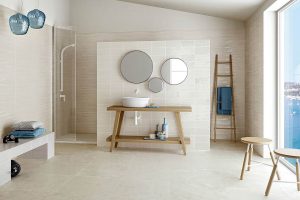 Hardwood Flooring: Elegance
Hardwood Flooring: Elegance
Hardwood flooring is a classic choice that has stood the test of time. Its natural beauty and durability make it a sought-after option for homeowners looking to add a touch of elegance to their space. Here's why hardwood is so highly regarded:
- Great Appeal: The warmth and beauty of real wood bring a sense of elegance to any room.
- Longevity: When properly cared for, hardwood floors can last for generations, increasing the value of your home.
- Environmental Benefits: Sustainable harvesting practices and renewable options make hardwood a responsible choice for eco-conscious consumers.
- Allergen-Friendly: Hardwood doesn't trap allergens like carpet, making it a great choice for those with allergies.
Tile Flooring: Durability and Versatility
Tile flooring is another durable and versatile option, especially in spaces with high moisture levels, such as bathrooms and kitchens. Tile offers a variety of styles and materials, including ceramic, porcelain, and natural stone. Here are some advantages of tile flooring:
- Water Resistance: Tile is highly resistant to moisture and is ideal for areas prone to spills and high humidity.
- Design Variety: Tiles come in various sizes, colors, and patterns, allowing you to create unique designs and customize your space.
- Ease of Maintenance: Tiles are easy to clean and are highly durable, withstanding daily wear and tear.
- Cool Comfort: Tile floors are naturally cool, making them an excellent choice for warm climates.
In conclusion, choosing the right flooring for your home involves a balance between aesthetics, practicality, and budget. Luxury vinyl, hardwood, and tile each offer their unique advantages, and the best choice depends on your personal preferences and the specific needs of your space. Whether you opt for the versatility of luxury vinyl, the timeless beauty of hardwood, or the durability of tile. A well-informed decision will ensure your flooring meets both your functional and aesthetic requirements.
How to Clean Grout in Tile Flooring
One of the common issues people have when they choose Tile Flooring is they need help to clean the grout between the tiles. Several easy-to-do steps can have your grout looking brand new in under two hours. Grout is the space between the tiles in your bath or kitchen, or wherever you place your tiles. If the grout is left untouched, the grout can collect mold, mildew, and dirt. Ensuring you clean the grout several times, a year can give your tiles a new fresh look.
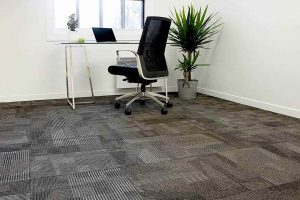
Step 1: Apply Grout Cleaner
- Before getting started, make sure you wear gloves to protect your hands from the cleaner and mold
- Next, apply any commercial tile cleaner, you will put it on all the dirty areas on the grout
- You can also create your own grout cleaner for your tiles. Use ¾ baking soda, ¼ hydrogen peroxide and 1 tablespoon of dish soap. You can apply it to the grout like you would with any other grout cleaner
Step 2: Scrub and Rinse Grout around the Tiles
- Next you will start scrubbing the grout using mops, towels, microfiber cloths, or sponges.
- Some will even use toothbrushes to ensure they get all the small crevices.
Step 3: How to remove difficult stains
- Apply your grout cleaning solution to all the grout, you can use store-bought solutions or homemade ones.
- Next you can use a steam cleaner to review all the surfaces. By scrubbing all the grout surfaces with the steam cleaner, you can ensure to get rid of all the stubborn stains.
Step 4: Preventing Grout Build up on Tile Flooring
- By cleaning the grout once a week, you can ensure to avoid build up of mold and dirt in the grout
- By pouring a small amount of rubbing alcohol on a cloth and wipe down the dirty grout and tiles.
- This will also kill mold and mildew and help keep the tiles and grout clean
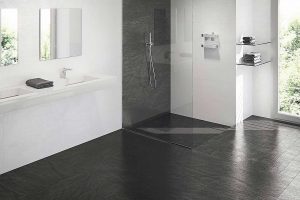
If you were able to clean your grout, congrats! Now may be a good time to reseal it. High-traffic areas should be resealed every 6 months to 1 year, while low-traffic areas can go 2–3 years between sealings. If the methods above didn’t work, it may be time to replace your grout.
By following these steps and frequently cleaning the grout often, you can avoid having your grout between your tile flooring looking old and gross. Although cleaning the grout may seem tedious and time consuming, it can keep your flooring look brand new.
Pros and Cons of Natural Hardwood Flooring
When considering putting any type of flooring in your house, its important to consider the pros and cons each type of flooring. For Hardwood Flooring, there are many pros and cons to consider, for example, hardwood floors can work in many types of rooms. This blog will go over some of the pros and cons related to Hardwood Flooring, and will give you more to consider about Hardwood Flooring.
Pros of Hardwood Flooring
Durability
One of the main reasons that drives people to purchase Hardwood Flooring, is its durability. Hardwood has the ability to be refinished and sanded down to give the hardwood a new fresh look. Having the ability to refinish the flooring can save you thousands of dollars, instead of having to install new floors, you can just give them a new, refreshed looked.
Hardwood Flooring is Easy to Maintain
Having floors that are low maintenance can be a large selling point for many people. Hardwood floors require very little maintenance, however they do need to be cleaned regularly like most floors. If you are able to sweep, vacuum, and mop regularly, the floors will hold their integrity and increase their life span. Interested in learning more about how to properly clean hardwood? Learn more here.
Endless Styles
If you are picky when it comes to your flooring, one of the many pros to hardwood is that they have endless options. There are many different natural wood options, that create various different styles and looks for your flooring. If you want to see some of the options we have for hardwood, make sure you come by our showroom to see the endless options!
Cons of Hardwood Flooring
Discoloration
If in direct sunlight, some types of hardwood can start to become discolored. Because of this, you may have to refinish your flooring early than you would like
Water Damage
One of the common complaints about hardwood is if water is left on hardwood for to long, it can damage the flooring and cause it to start peeling or become worn out. So if you experience flooding in a specific room, or have pets that are constantly spilling water in areas from their water bowl, you may not want to put hardwood in those rooms.
Interested in learning more about the Pros and Cons of Hardwood? Call or visit our storefront where a team member can walk you through the different options, and determine what's best for you and your project.
Pros and Cons of Luxury Vinyl Flooring (LVP)
Over the past few years, Luxury Vinyl Flooring (LVP) has gained much traction. One of the main reasons people have been leaning toward Luxury Vinyl (LVP) is because of its affordability of it compared to other options such as hardwood.
Pros of Luxury Vinyl
Easy to Install
LVP is very easy to install. Because of how straightforward the installation is, many people opt to try installing the flooring themselves. This helps reduce the overall cost of purchasing the flooring, and also you are able to install them on your own schedule.
Durability
Luxury Vinyl Flooring very durable flooring option for both residential and commercial installations. Many are waterproof, which means they can be installed anywhere, including wet areas like bathrooms, kitchens, laundry rooms, and basements, while others are water-resistant. They also resist other things like moisture, mold, mildew, stains, scratches, and scuffs.
Luxury Vinyl Flooring has Unique Designs
With Luxury Vinyl Flooring, the design options are endless. There are thousand of options when it comes to designs for LVP, which ensures you are able to find your dream design for you floors.
Cons of Luxury Vinyl
May not do well in Sunlight
Depending on the brand and quality of Luxury Vinyl that you go with, some of the cheaper brands do not do well in sunlight. When purchasing LVP its important to do your research on what brand you are using, and look at the reviews to ensure the quality is good.
LVP can be hard to remove
Once the Luxury Vinyl is installed, it can be hard to remove if you change your mind. This is due to the adhesive glue used to keep them in place.
How To Clean Hardwood Floors
Sweep or Vacuum the Hardwood Floors
Regardless of what type of hardwood floor you have, the first step you should take when trying to clean your floors is to sweep or vacuum your floors. Regardless if you are cleaning your floors or refinishing them, this should be the first step. Using a regular broom or vacuum tends to do the trick, but you can also you a microfiber dust mop, that can remove excess dust and help remove scratches on the floor. When vacuuming hardwood floors, turning the brush rolls off is very important. This will help prevent them from scratching the floors. Hardwood floors can hide certain types of dirt differently than carpet, so its important to sweep or vacuum regularly. 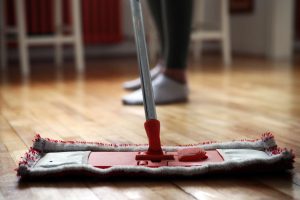
Mopping the Floors
When mopping hardwood flooring, it is important to ensure you wring out the majority of the water before starting to mop. Too much water can result in the water damaging the floor. Furthermore, be sure to go over every spot multiple times; this is to help ensure that there are no water spots left on the hardwood, as this can result in damaging the surface. Steaming cleaning your floors is typically not encouraged for hardwood floors. Steam cleaning it can dull and ruin the finish of your floors, which can be pricey to repair. Lastly, when using floor cleaners, make sure you use hardwood floor cleaners specifically, avoid tile cleaners and vinyl cleaners.
Giving Your Floors a Refreshed Look
Keeping your floors clean is the first step, but keeping them looking fresh and removing the occasional scratch and dullness is another thing. You can use a liquid scratch concealer that you put on your floor after cleaning them. This will create a permanent seal on your floors that doesn't come off during cleaning. You can also restore your floors and shine them by using any wood floor polish. This will help protect your floor from any wear and tear, and also help reduce the number of scratches.
Want to learn more about taking care of hardwood floors, or thinking of switching to hardwood? Connect with a team member today, and we would love to help you with the next steps!
Where To Use Tile Flooring And Why
Choosing the right flooring for your home is crucial to its aesthetics and functionality. Tile flooring, with its durability and great appeal, is a popular choice for many homeowners. However, deciding where to install tile flooring in your house is equally important.
-
Kitchen
The kitchen is a natural fit for tile flooring. Its resistance to moisture, easy maintenance, and durability make it perfect for the high-traffic area. Spills, splashes, and frequent cleaning are part of daily life in the kitchen, and tile flooring can easily handle them. Whether you opt for ceramic, porcelain, or stone tiles, you'll find various design options to complement your kitchen's style.
-
Bathroom

Tile flooring in bathrooms is a classic choice. Their moisture-resistant properties are key in a space where water is often present. Porcelain or ceramic tiles work particularly well here, offering both style and practicality. Their smooth surfaces are easy to clean, and they can withstand the daily rigors of a bathroom environment.
-
Entryway and Mudroom
Entryways and mudrooms are high-traffic areas that are frequently exposed to the elements. Tile flooring is an excellent choice in these spaces because it can endure the wear and tear of shoes, boots, and wet coats. It also makes cleaning up dirt and debris a breeze, ensuring your home stays tidy.
-
Laundry Room
The laundry room is another area where tile flooring shines. Spills from detergents and water leaks from washing machines are common occurrences. The moisture resistance of tile flooring can help prevent water damage to your home's structure. Additionally, it's easier to clean up any detergent or bleach spills on tile compared to other flooring materials.
-
Basement
Basements can be prone to moisture issues, making it a wise choice. It's a barrier against moisture seeping through the concrete slab, preventing mold and mildew growth. While carpet or laminate can be used in basements, it provides added peace of mind in an area that is susceptible to humidity and potentially flooding.
-
Outdoor Spaces
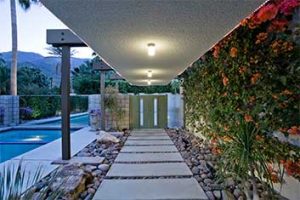 Many homeowners are now extending the use of tile flooring to outdoor spaces such as patios, decks, and pool surrounds. Porcelain or natural stone flooring can create an elegant and durable outdoor living area.
Many homeowners are now extending the use of tile flooring to outdoor spaces such as patios, decks, and pool surrounds. Porcelain or natural stone flooring can create an elegant and durable outdoor living area.
-
Living Areas
It is not limited to high-moisture or high-traffic areas. In some living areas, such as the dining room or living room, it can make a great impression. These spaces can benefit from the durability and design versatility of tile flooring. They can look similar to natural wood or stone while offering easier maintenance.
Choosing where to install tile flooring in your house involves a thoughtful consideration of practicality and aesthetics. Whether you're prioritizing durability in high-traffic areas, moisture resistance in wet spaces, or simply adding a touch of timeless elegance to your living areas, tile flooring can be a versatile and functional choice. With the wide variety of materials, colors, and patterns available, you can find the perfect tile flooring to suit your needs and style.
Reasons To Chose Luxury Vinyl Flooring
 LVP is engineered to be incredibly durable, making it suitable for high-traffic areas and even commercial spaces. It's resistant to scratches, dents, and moisture, making it an ideal choice for kitchens, bathrooms, and entryways where accidents are more likely to occur. This durability ensures that your investment will stand the test of time, looking as luxurious and pristine as the day it was installed.
LVP is engineered to be incredibly durable, making it suitable for high-traffic areas and even commercial spaces. It's resistant to scratches, dents, and moisture, making it an ideal choice for kitchens, bathrooms, and entryways where accidents are more likely to occur. This durability ensures that your investment will stand the test of time, looking as luxurious and pristine as the day it was installed.
Luxury Vinyl Flooring is a great option nonetheless. They are one of the easiest floors to maintain and they can last a significant amount of time. Walking on luxury vinyl flooring is a comfortable and quiet experience, making it an excellent choice for bedrooms and living areas where comfort matters. LVP comes in many different patterns, colors, and textures. It can match virtually any design concept or theme, from rustic to modern and everything in between.
LVP is a composite flooring type that was originally designed for commercial applications making it extremely durable. While luxury vinyl plank has now stormed the residential market, the exceptional quality and hard-wearing surfaces have remained the same except to create better looks that suit home use. We recommend choosing something you will love for decades because you're likely to outgrow your taste before you'll ever wear out this flooring!

The installation process can significantly impact the overall cost of your flooring project. Luxury vinyl flooring is very well easy to install, which saves a lot of time and money. It can often be installed directly over existing flooring, eliminating the need for expensive and time-consuming. However you should consult a professional for their opinion.
Luxury vinyl flooring has redefined what it means to have a luxurious and stylish interior. With the ability to replicate the look and feel of natural materials like hardwood, stone, and tile. It is widely used as people have realized its durability, cost-effectiveness and altogether luxurious look. The wide range of styles and patterns available ensures a luxury vinyl flooring option to suit every design preference.
5 Reasons Why You Should Choose Hardwood Flooring
Hardwood flooring can make your next home project that much more exciting!
Many factors make people lean towards hardwood floor, but there are 5 common reasons.
- Many factors make Hardwood Flooring a go-to option for many people, and one of the main reasons is its cleaning ability. Unlike carpet, there is no dirt or germs that can hide in the carpet, as long as you sweep and mop on occasion, the floor will stay clean. Sweeping and mopping with a damp mop are all you need for general wood maintenance. Spot cleaning can be done with gentle cleaners made for hardwood flooring. You can even vacuum hardwood floors, but choose a vacuum without a beater bar or one with a hard floor mode that doesn’t engage the bar.
- Hardwood Flooring is timeless, and can be used in any areas whether its a bedroom, bathroom, kitchen, living room, or even a dining room. Hardwood flooring can even be used in basements, because they can be more water resistant than most other flooring options.
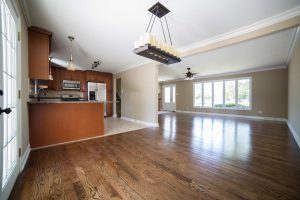
- Hardwood floors wear very well. Whether you have pets, kids, or just yourself walking around your house, hardwood floor can be very durable. If you use proper protectant for floor sealer, the floors can last years.
- Hardwood floors are able to be refinished upwards of 7 times before needing to be replaced! This makes hardwood life span significantly longer due to being able to be refinished, which can make them look brand new again!
- Hardwood floors hold up well with pets! Whether you have a dog that sheds, pet that are messy eaters, with hardwood floor it makes the clean up easier! With the proper protectant and care, you hardwood floor can hold up for a long time even with pets.
Value in choosing hardwood
The long-term value of hardwood flooring is worth the cost that you pay when you first purchase the item, according to most homeowners and professionals. The longevity and simplicity of upkeep of hardwood flooring will decrease cleaning and repair expenditures in the long run, which is extremely helpful towards both yourself and your home’s value.
Prospective homebuyers dislike carpet, especially carpet that belongs to someone else because they are easily stainable and they attract and contain all kinds of dirt over time. That is why hardwood flooring and underfloor heating are highly sought-after features in real estate. These kinds of features in flooring may considerably increase the sale speed of your home, if you plan on selling it and moving to a different home in the future.
The flooring that you choose has a great impact on various aspects of your home. Your selection of the floors for your home can heavily affect your home’s aesthetics, structural integrity and future value. With that being said, throughout the process of choosing the flooring for you and your home, you must do your research and indulge in the information of all the types of floors that are available on the market. If you are having a bit of trouble deciding which type to choose, the safest and most common option that most homeowners tend to lean towards is hardwood flooring.
The Elegant options of Tile Flooring
Regarding flooring options, it can become very costly, Tile flooring can be an inexpensive option. Tile flooring has an elegant and sleek look. It can come in many different shapes and sizes which is suitable for any room in a house. It only takes a phone call to get a quote to transform your home and your life.
The Advantages of Tile Flooring

Durability: Tile flooring is well-known for its longevity. When properly maintained, tile floors can last for decades, making them a cost-effective choice in the long run.
Aesthetic Versatility: Tiles come in various shapes, sizes, colors, and textures, making them suitable for a wide range of design styles. From sleek and modern to rustic and traditional, there's a tile to suit every taste. Easy Maintenance: Cleaning tile flooring is very easy. Regular sweeping and occasional mopping will keep your floors looking pristine. However, tiles resist stains, which is especially beneficial in high-traffic areas. Hygienic and Allergy-Friendly: Unlike carpet, tile flooring does not trap allergens, making it a healthier option for those with allergies or respiratory issues. It's also an excellent choice for homes with pets.
Water Resistance: Tile is naturally resistant to moisture, making it a perfect flooring option for bathrooms, kitchens, and even outdoor spaces like patios and porches.
Types of Tile Flooring
- Ceramic Tiles: Ceramic tiles are popular due to their affordability and versatility. They are available in various colors and patterns and can mimic the look of natural stone or wood.
- Porcelain Tiles: Porcelain tiles are known for their strength and durability. They are highly resistant to water, stains, and scratches, making them suitable for both indoor and outdoor applications.
- Natural Stone Tiles: Natural stone tiles, such as marble, granite, travertine, and slate, provide a luxurious look. Each type of stone offers unique colors and textures that add a touch of elegance to any space.
- Mosaic Tiles: Mosaic tiles are small, decorative tiles that come in various materials, including glass, ceramic, and stone. They are often used to create intricate patterns and designs, adding a unique flair to your flooring. Porcelain Wood-Look Tiles: For those who love the look of hardwood but want the durability of tile, porcelain wood-look tiles are an excellent choice. They mimic the appearance of wood while offering the benefits of tile.
Caring for Your Flooring
To ensure your tile flooring maintains its beauty and longevity, follow these care tips:
- Regular Cleaning: Sweep or vacuum debris and dust regularly. Use a damp mop with a mild cleaner for a deeper clean.
- Avoid Harsh Chemicals: Steer clear of abrasive cleaners or acidic solutions that can damage the flooring or grout.
- Seal Grout Lines: Grout is susceptible to stains and moisture. Apply a grout sealer to protect it and keep it looking fresh.
- Use Mats and Rugs: Place mats at entryways and rugs in high-traffic areas to prevent dirt and scratches on your floor.
- Address Spills Promptly: Wipe up spills as soon as they occur to prevent staining and grout discoloration.
Tile flooring is a beautiful and practical choice for homeowners looking to enhance their living spaces. With its durability, aesthetic versatility, and low maintenance requirements, tile flooring has made itself its place as a classic and a great option. Whether you opt for ceramic, porcelain, natural stone, or mosaic tiles, the timeless elegance of tile flooring can elevate the look and feel of your home while providing a durable and hygienic surface that stands the test of time.
So, consider tile flooring for your next home improvement project and discover the transformative power of this remarkable flooring option.

